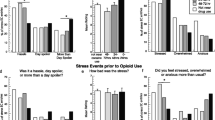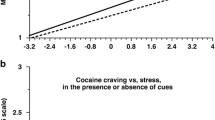Abstract
Rationale
Ecological momentary assessment (EMA) of specific events usually focuses more on antecedents and concomitants than on aftermaths.
Objectives
To examine mental state both before and after discrete episodes of stress and drug use.
Methods
For up to 16 weeks, outpatients on opioid-agonist treatment carried smartphones on which they initiated entries for stressful events (SEs) or lapses to drug use (DUs), and thrice daily when randomly prompted (RPs). Participants rated their stress, opioid craving, cocaine craving, and moods. RP entries within 5 h of an event were analyzed and compared to other RPs.
Results
Stress, negative mood, and craving were generally higher before and after DUs and SEs compared to background levels in participants with at least one DU (n = 149) or SE (n = 158). Before DUs, there were increases in negative mood, opioid craving, and cocaine craving, but not background stress. Before SEs, there were increases in background stress, opioid craving, and cocaine craving, but not negative mood. These changes were more variable after events than before. Neither DUs nor SEs were significantly related to positive mood.
Conclusions
Stress increased before stressful-event entries, but was less evident before drug use. Craving increased in the hours before drug use and stressful events—and remained elevated in the hours after either event. These results suggest a stronger link between drug use and craving than between drug use and stress. Lapses to drug use did not improve mood or reduce stress, at least not at our 1-h-bin time resolution, suggesting that if such benefits exist, they are brief.


Similar content being viewed by others
References
Abroms LC, Johnson PR, Leavitt LE, Cleary SD, Bushar J, Brandon TH, Chiang SC (2017) A randomized trial of text messaging for smoking cessation in pregnant women. Am J Prev Med 53:781–790
Businelle MS, Ma P, Kendzor DE, Frank SG, Wetter DW, Vidrine DJ (2016) Using intensive longitudinal data collected via mobile phone to detect imminent lapse in smokers undergoing a scheduled quit attempt. J Med Internet Res 18:e275
Campbell EM, Jia H, Shankar A, Hanson D, Luo W, Masciotra S, Owen SM, Oster AM, Galang RR, Spiller MW, Blosser SJ, Chapman E, Roseberry JC, Gentry J, Pontones P, Duwve J, Peyrani P, Kagan RM, Whitcomb JM, Peters PJ, Heneine W, Brooks JT, Switzer WM (2017) Detailed transmission network analysis of a large opiate-driven outbreak of HIV infection in the United States. J Infect Dis 216:1053–1062
Dowell D, Arias E, Kochanek K, Anderson R, Guy GP Jr, Losby JL, Baldwin G (2017) Contribution of opioid-involved poisoning to the change in life expectancy in the United States, 2000-2015. JAMA 318:1065–1067
Epstein DH, Willner-Reid J, Vahabzadeh M, Mezghanni M, Lin JL, Preston KL (2009) Real-time electronic diary reports of cue exposure and mood in the hours before cocaine and heroin craving and use. Arch Gen Psychiatry 66:88–94
Epstein DH, Marrone GF, Heishman SJ, Schmittner J, Preston KL (2010) Tobacco, cocaine, and heroin: craving and use during daily life. Addict Behav 35:318–324
Furnari M, Epstein DH, Phillips KA, Jobes ML, Kowalczyk WJ, Vahabzadeh M, Lin JL, Preston KL (2015) Some of the people, some of the time: field evidence for associations and dissociations between stress and drug use. Psychopharmacology 232:3529–3537
Gustafson DH, McTavish FM, Chih MY, Atwood AK, Johnson RA, Boyle MG, Levy MS, Driscoll H, Chisholm SM, Dillenburg L, Isham A, Shah D (2014) A smartphone application to support recovery from alcoholism: a randomized clinical trial. JAMA Psychiatry 71:566–572
Lin M, Mahmooth Z, Dedhia N, Frutchey R, Mercado CE, Epstein DH, Preston KL, Gibbons MC, Bowie JV, Labrique AB, Cheskin LJ (2015) Tailored, interactive text messages for enhancing weight loss among African American adults: the TRIMM randomized controlled trial. Am J Med 128:896–904
Mahoney JJ 3rd, Kalechstein AD, De La Garza R 2nd, Newton TF (2007) A qualitative and quantitative review of cocaine-induced craving: the phenomenon of priming. Prog Neuro-Psychopharmacol Biol Psychiatry 31:593–599
McLellan AT, Luborsky L, Cacciola J, Griffith J, Evans F, Barr HL, O'Brien CP (1985) New data from the addiction severity index: reliability and validity in three centers. J Nerv Ment Dis 173:412–423
Preston KL, Epstein DH (2011) Stress in the daily lives of cocaine and heroin users: relationship to mood, craving, relapse triggers, and cocaine use. Psychopharmacology 218:29–37
Preston KL, Vahabzadeh M, Schmittner J, Lin JL, Gorelick DA, Epstein DH (2009) Cocaine craving and use during daily life. Psychopharmacology 207:291–301
Preston KL, Kowalczyk WJ, Phillips KA, Jobes ML, Vahabzadeh M, Lin JL, Mezghanni M, Epstein DH (2017) Context and craving during stressful events in the daily lives of drug-dependent patients. Psychopharmacology 234:2631–2642
Preston KL, Kowalczyk WJ, Phillips KA, Jobes ML, Vahabzadeh M, Lin JL, Mezghanni M, Epstein DH (2018) Exacerbated craving in the presence of stress and drug cues in drug-dependent patients. Neuropsychopharmacology 43:859–867
Robins LN, Cottler LB, Bucholz KK, Compton WM III (1995) The diagnostic interview schedule, Version IV. Washington University, St. Louis
Rudd RA, Seth P, David F, Scholl L (2016) Increases in drug and opioid-involved overdose deaths—United States, 2010-2015. MMWR Morb Mortal Wkly Rep 65:1445–1452
Scott CK, Dennis ML, Gustafson DH (2017) Using smartphones to decrease substance use via self-monitoring and recovery support: study protocol for a randomized control trial. Trials 18:374
Scott-Sheldon LA, Lantini R, Jennings EG, Thind H, Rosen RK, Salmoirago-Blotcher E, Bock BC (2016) Text messaging-based interventions for smoking cessation: a systematic review and meta-analysis. JMIR Mhealth Uhealth 4:e49
Shiffman S, Waters AJ (2004) Negative affect and smoking lapses: a prospective analysis. J Consult Clin Psychol 72:192–201
Shiffman S, Stone AA, Hufford MR (2008) Ecological momentary assessment. Annu Rev Clin Psychol 4:1–32
Sinha R, Garcia M, Paliwal P, Kreek MJ, Rounsaville BJ (2006) Stress-induced cocaine craving and hypothalamic-pituitary-adrenal responses are predictive of cocaine relapse outcomes. Arch Gen Psychiatry 63:324–331
Treloar H, Piasecki TM, McCarthy DM, Sher KJ, Heath AC (2015) Ecological evidence that affect and perceptions of drink effects depend on alcohol expectancies. Addiction 110:1432–1442
Vahabzadeh M, Epstein DH, Mezghanni M, Lin J-L, Preston KL (2004) An electronic diary software for ecological momentary assessment (EMA) in clinical trials. Proceedings of the 17th IEEE Symposium on Computer-Based Medical Systems (CBMS) 167–172
Vahabzadeh M, Mezghanni M, Lin J-L (2012) Context aware mobile device software for substance abuse interventions and behavioral modification. Fed Regist 77:48997–48998
Yarkoni T, Westfall J (2017) Choosing prediction over explanation in psychology: lessons from machine learning. Perspect Psychol Sci 12:1100–1122
Zibbell JE, Asher AK, Patel RC, Kupronis B, Iqbal K, Ward JW, Holtzman D (2018) Increases in acute hepatitis C virus infection related to a growing opioid epidemic and associated injection drug use, United States, 2004 to 2014. Am J Public Health 108:175–181
Funding
This study was supported by the Intramural Research Program of the National Institute on Drug Abuse, National Institutes of Health.
Author information
Authors and Affiliations
Corresponding author
Ethics declarations
Conflict of interest
The authors declare that they have no conflict of interest.
Electronic supplementary material
ESM 1
(DOCX 1074 kb)
Rights and permissions
About this article
Cite this article
Preston, K.L., Kowalczyk, W.J., Phillips, K.A. et al. Before and after: craving, mood, and background stress in the hours surrounding drug use and stressful events in patients with opioid-use disorder. Psychopharmacology 235, 2713–2723 (2018). https://doi.org/10.1007/s00213-018-4966-9
Received:
Accepted:
Published:
Issue Date:
DOI: https://doi.org/10.1007/s00213-018-4966-9




